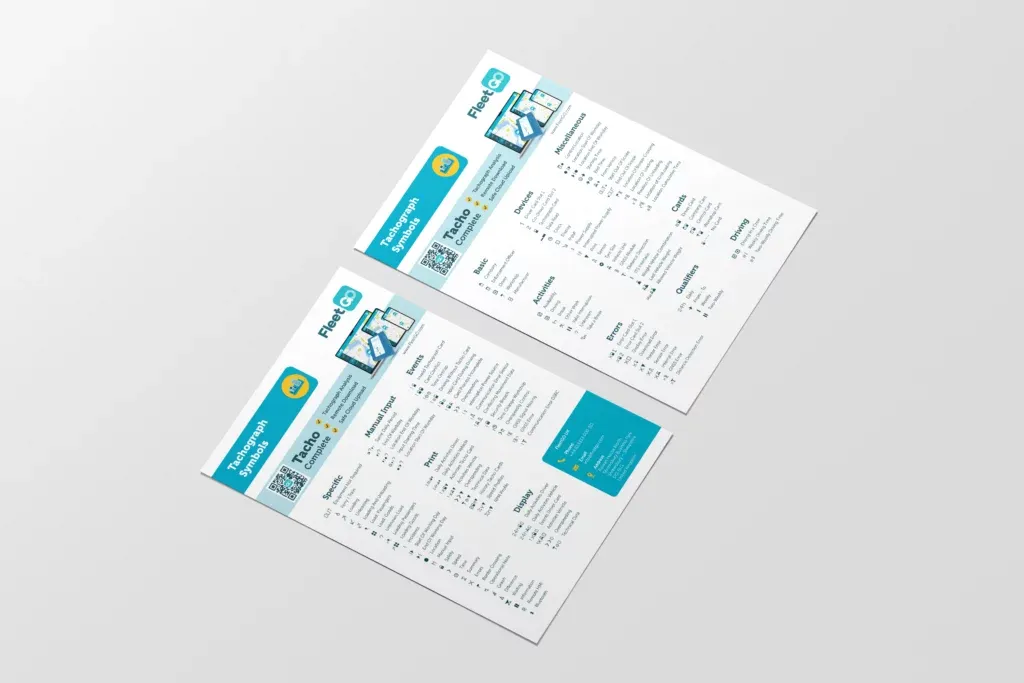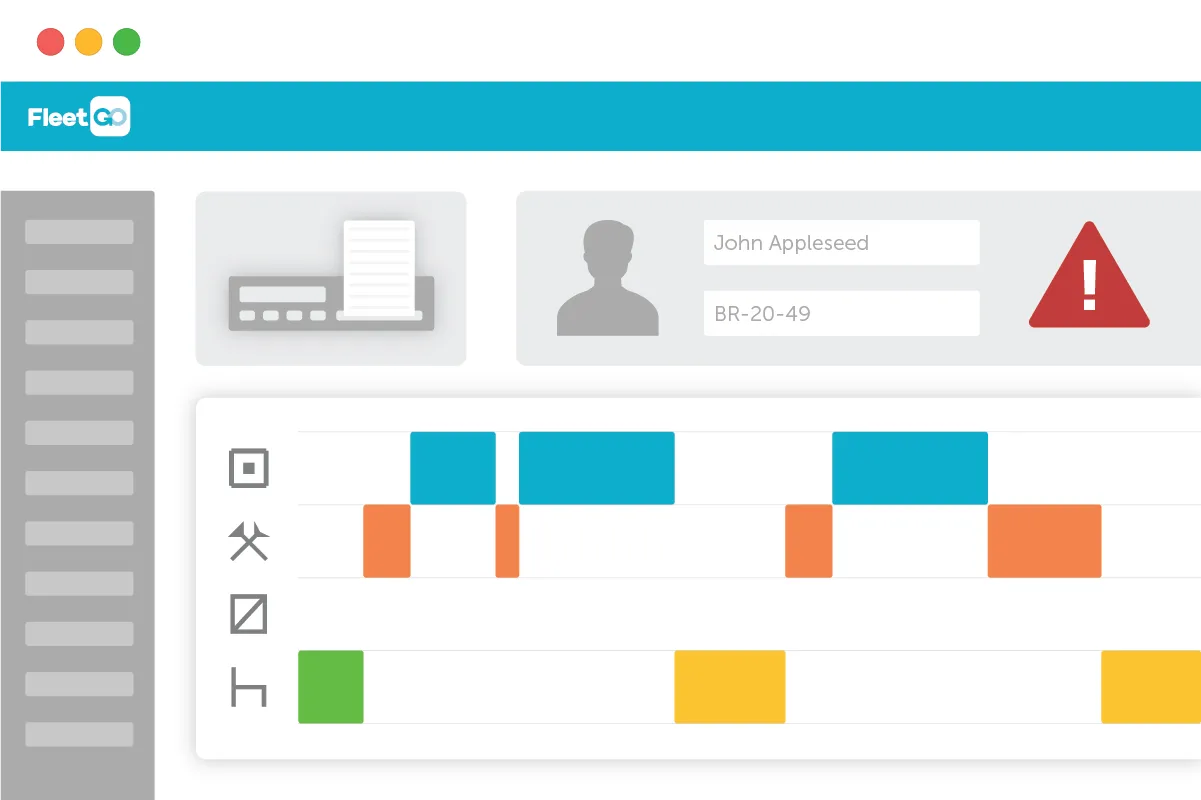Onboard diagnostics collects a vehicle’s signals and transmits tachograph fault codes in case of a problem. Since the digital tachograph is attached to the OBD-II, it receives signals from the vehicle and notifies the driver or fleet manager through the fault codes. Commercial vehicles are complex machines, and system failures can happen anytime. Fortunately, drivers don’t have to wonder what the problem is since the alerts appear on the dashboard or the fleet management system. Aside from the light signalling the malfunction, fault codes pinpoint the exact issue in the vehicle within seconds.

Download the Tachograph Symbol overview
Get it for FREE!

What Are Digital Tachograph Fault Codes?
A digital tachograph is usually fitted in commercial vehicles to record various driver and car data types. The tachograph can relay information on the location, speed, driver’s activity and journey distance. Information from the digital tachographs is stored in the vehicle unit memory. It can be retrieved by remotely downloading or accessing it from a fleet tracking management system. Aside from monitoring the driver’s activities, a tachograph also relays information on faults and malfunctions in the car.
Since the tachograph is attached to the onboard diagnostic system, it has access to the diagnostic trouble codes that vehicles use to notify drivers about an issue. Each code corresponds to a defect detected in the car and activates the corresponding diagnostic trouble code. Fault codes help drivers identify and fix malfunctions in the vehicle. While OBD-II diagnostic codes help analyse the vehicle’s problems, digital tachograph fault codes relay problems in the tachograph unit. The fault codes are usually stored in the tachograph unit and shown on display. A tachograph fault code will appear on the screen until the problem is resolved.
Unlike the vehicle unit that displays diagnostic trouble codes to illustrate issues in a vehicle, a tachograph displays fault codes. The OBD-II diagnostic codes usually have one letter (that demonstrates the category of the problem) and four digits (that identify manufacturing and generic issues). On the other hand, a tachograph fault code is illustrated by pictogram combinations, informative text and fault code numbers. The pictogram is specified according to the legal requirements, while the informative text demonstrates the source of the problem. A fault code number indicates the specific issues in the tachograph unit.
Tachograph fault codes are visible on the tachograph display, and the background light flashes for 30 seconds when a new fault code appears. A warning lamp makes the driver aware of any warnings and messages. During troubleshooting, the fault codes act as indicators. When the fault code is no longer active, drivers know the problem has been resolved. A fault code doesn’t mean the tachograph unit is faulty and needs to be changed. Fixing the underlying issue clears the fault codes from the display unit.
Standard Siemens Digital Tachograph Fault Codes
Some of the common Siemens digital tachograph fault codes include the following:
Internal fault codes
When the tachograph unit indicates an internal fault code, it means a serious fault has occurred in the tachograph. Alternatively, there could be a communication fault between the programming tool and the tachograph. The possible cause of defects includes changes in the position of the starter key during calibration. Interruption of the feed voltage to the programming tool or tachograph or loss of connection in the wiring can also cause a fault in the tachograph. The appropriate action for resolving the internal defects is to check the wiring and the programming tool connector. Drivers should also check the power supply to the programming tool and the tachographs. When the fault code remains without any changes, the driver should change the tachograph.
Timing fault
If the Stoneridge digital tachograph fault codes show a timing fault, it indicates the times are not plausible. The possible cause of the fault codes could be the clock running incorrectly. Drivers should check the UTC in the tachograph and correct it using the programming tool. The digital tachograph should be replaced if the fault code is not resolved.
Display fault
A display fault code appears when the display disappears in the tachograph unit. The possible causes of the codes are defects in the internal transfer to the display or a defective display. You should resolve the problems or change the tachograph if the fault code doesn’t disappear.
Calibration fault
When the checksum for a calibration calculation is incorrect, or if there is an internal fault, the calibration fault code will appear. Changing the tachograph unit can resolve the problem.
Fault code 10
If the tachograph displays a Fault Code 10, there are no speed signal pulses. The tachograph cannot monitor the speed signal to the vehicle unit. Possible causes of the faults include loose connections or oxidation in the vehicle control unit connector and the tachograph. A break in signal and internal defects can also cause Fault Code 10. Drivers should check the vehicle’s electronic control unit connectors and the tachographs to resolve the problems. Resolving problems with the voltage and checking the signal lines also resolves the issues.
Sensor fault
After self-testing, a road speed sensor can indicate an internal fault caused by a defective speed sensor. The appropriate resolution is for the driver to check or change the sensor.
Security infringement
A security breach code results from deficient data reliability, problems in the internal sensor fault or incomplete data in the road speed sensor. The cause of the fault could be a defect in the sensor due to tampering. Drivers can resolve the problem by checking the speed sensor or using the programming tool to match the sensor to the tachograph.
Voltage failure
When a break in the road speed sensor is detected, a voltage failure fault code appears on the screen to indicate loose connections and contact resistance in the sensor. The fault is caused by voltage variation in the tachograph power feed or a short circuit of the road speed sensor.
Never risk any tachograph fines again!
Get started with analysing your tachograph files with the FleetGO all-in-one tacho solution. Never miss an infringement again!
Chances of getting invested are higher than ever!

How To Read VDO Tachograph Fault Codes
Drivers and fleet managers require a manual to interpret VDO tachograph fault codes. However, before interpretation begins, drivers should read the codes to identify the cause of the faults. Most digital tachographs relay information to the vehicle management systems. That means fleet managers can access the fault codes from the software and interpret them. The fault codes are available in real time from the software, and drivers also receive alerts on the dashboard. When the driver cannot interpret the fault codes, the fleet managers can help them identify the cause of the fault and resolve it.
When faults are complex and require an expert, the driver should download the data from the tachograph before the repairs. The fault code will disappear when the issue is resolved. Alternatively, changing the tachograph resolves the problem and removes the fault codes.
Conclusion
Tachograph fault codes are useful in identifying and resolving problems in digital tachographs. Besides, they provide instant notification on the issues in the tachographs. Fault codes help fleet managers identify issues in the tachographs on time and resolve them to ensure compliance with the legislation. Drivers can also resolve issues before they escalate.
Sources:
Disclaimer
This content is provided for informational purposes only and is not meant to be an endorsement or representation by FleetGO.com or any other party. This information may contain inaccuracies or typographical errors, despite our efforts to ensure accuracy. FleetGO.com accepts no responsibility or liability for any errors or omissions, and is not responsible for the contents of any linked website or any link contained in a linked website. Please refer to our full disclaimer for more details.


